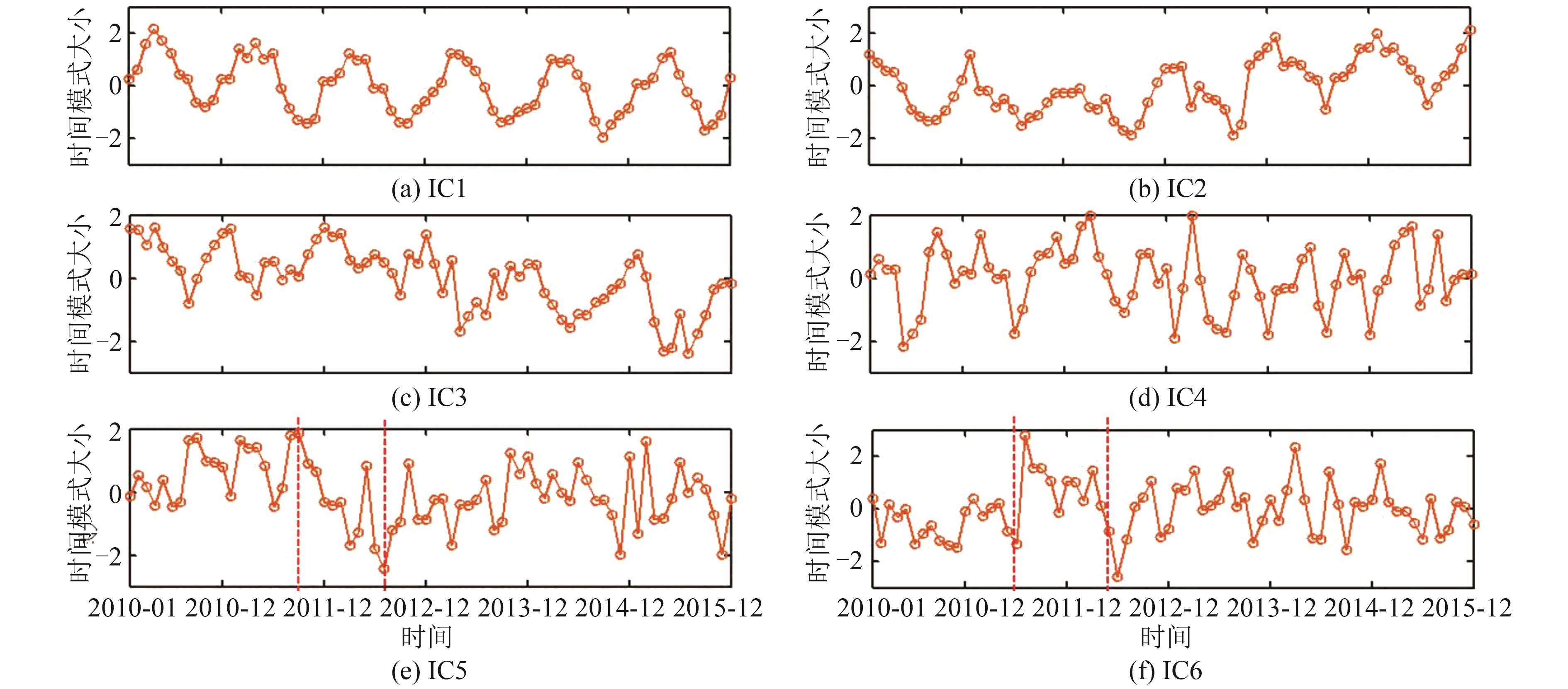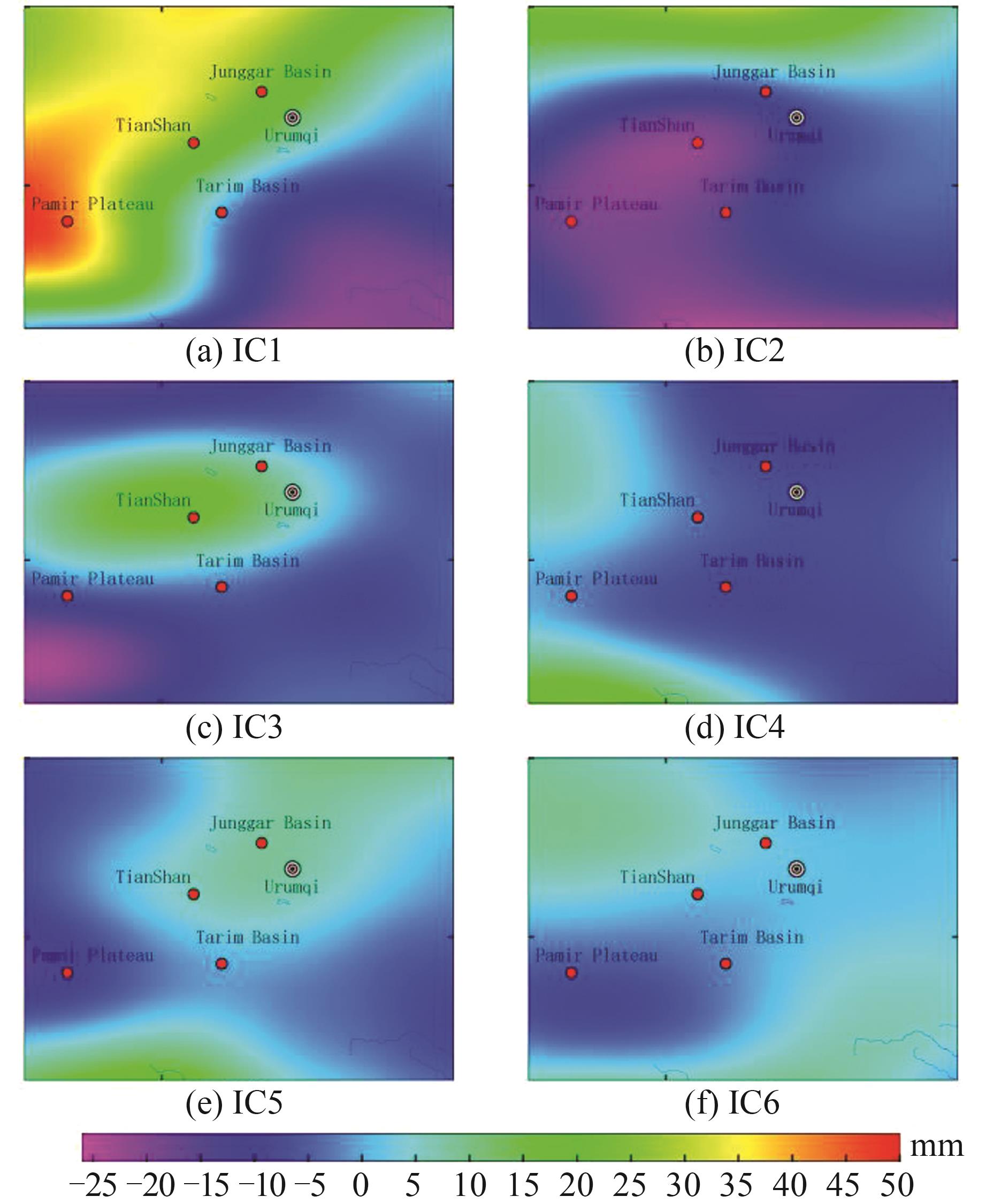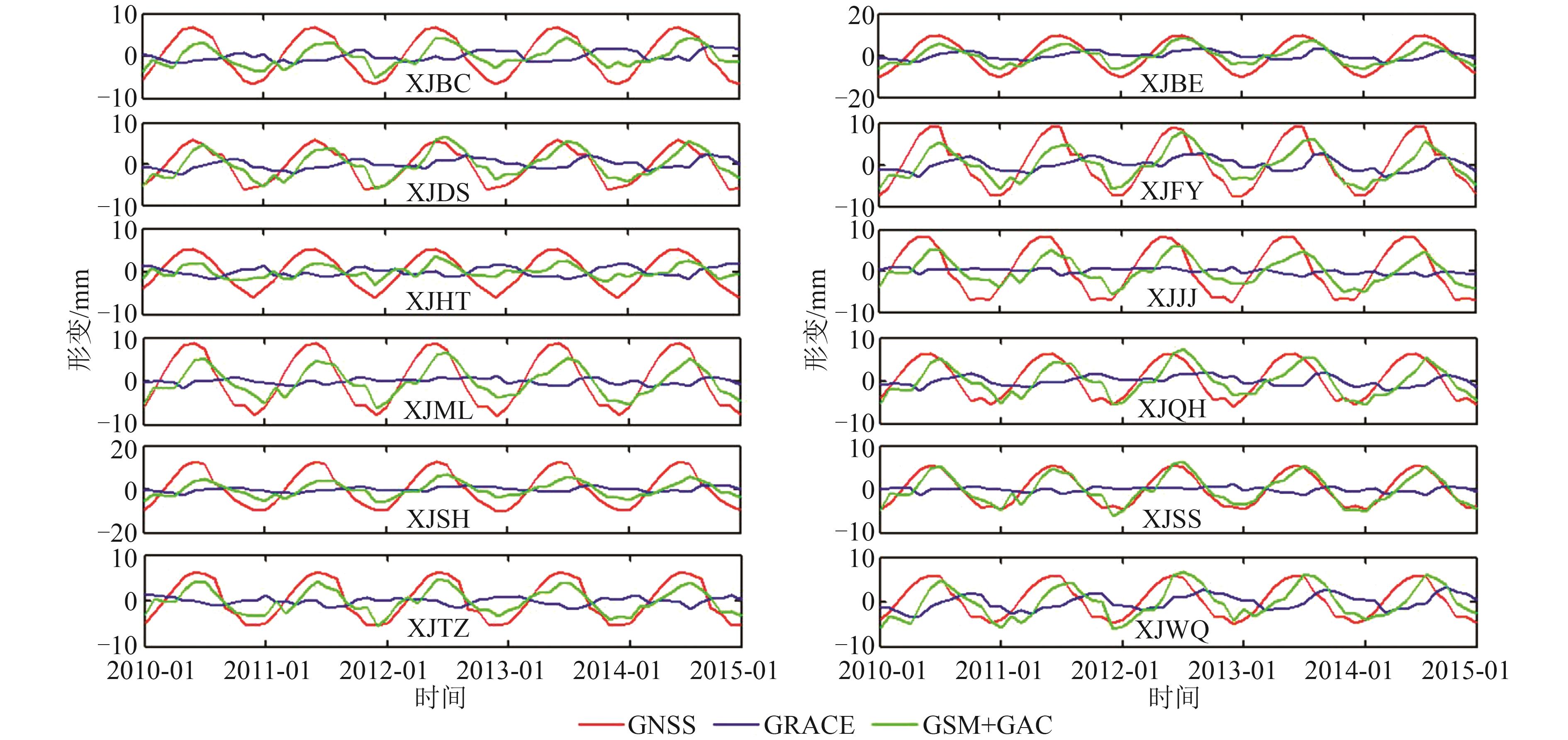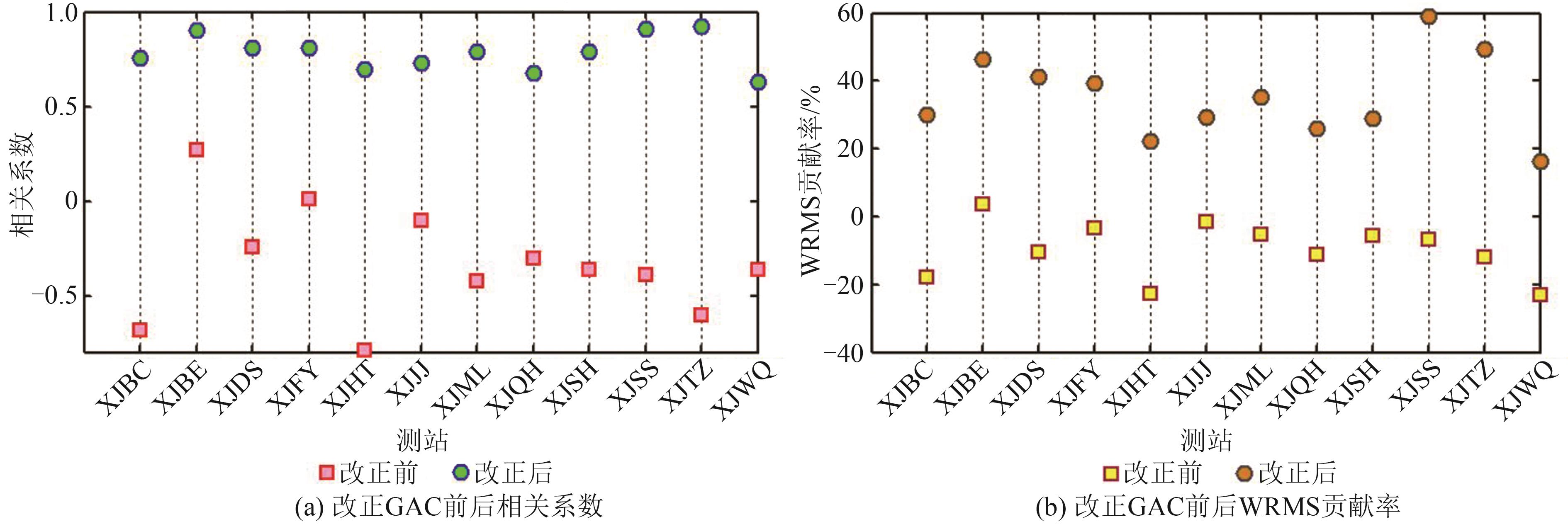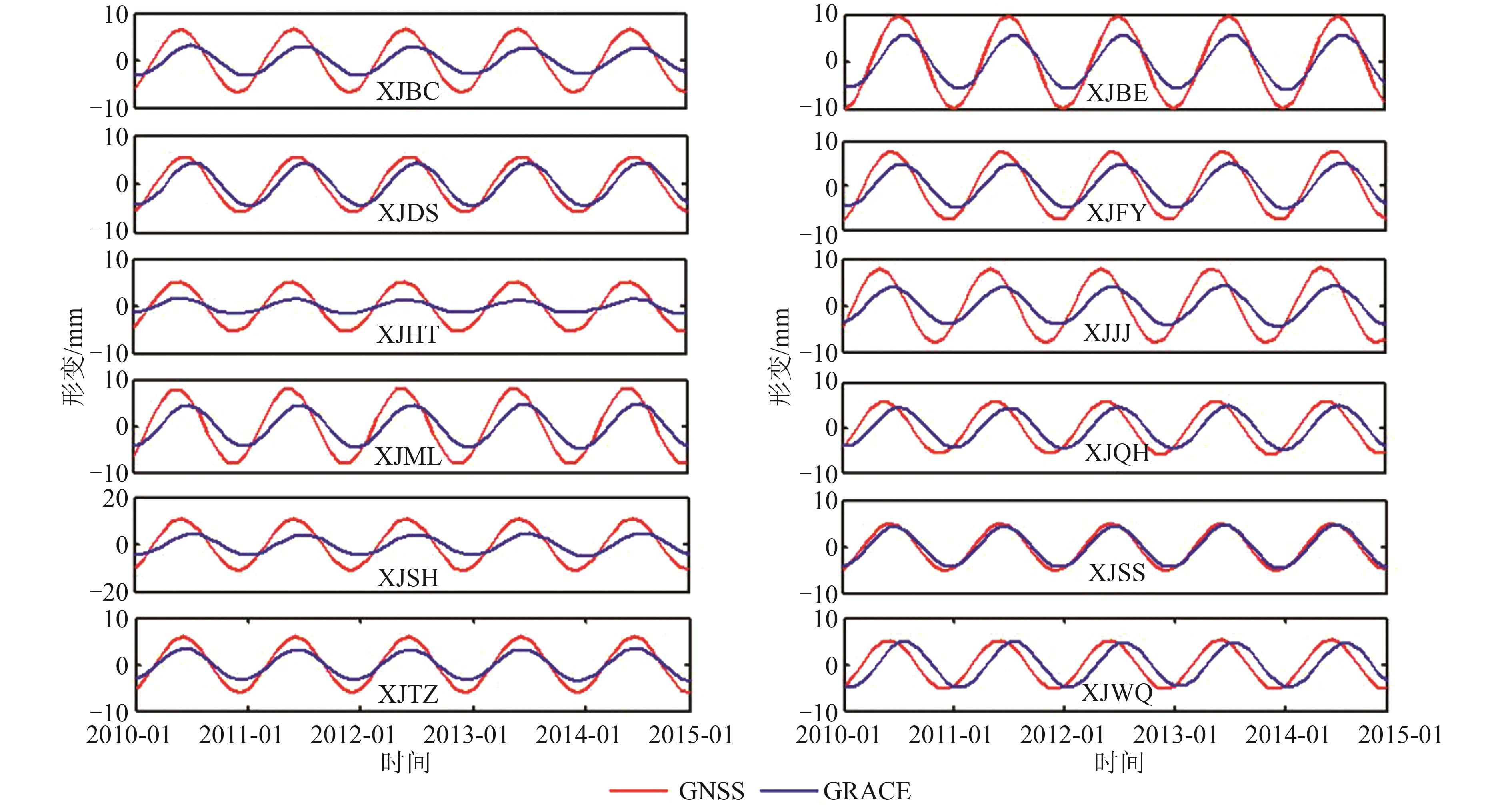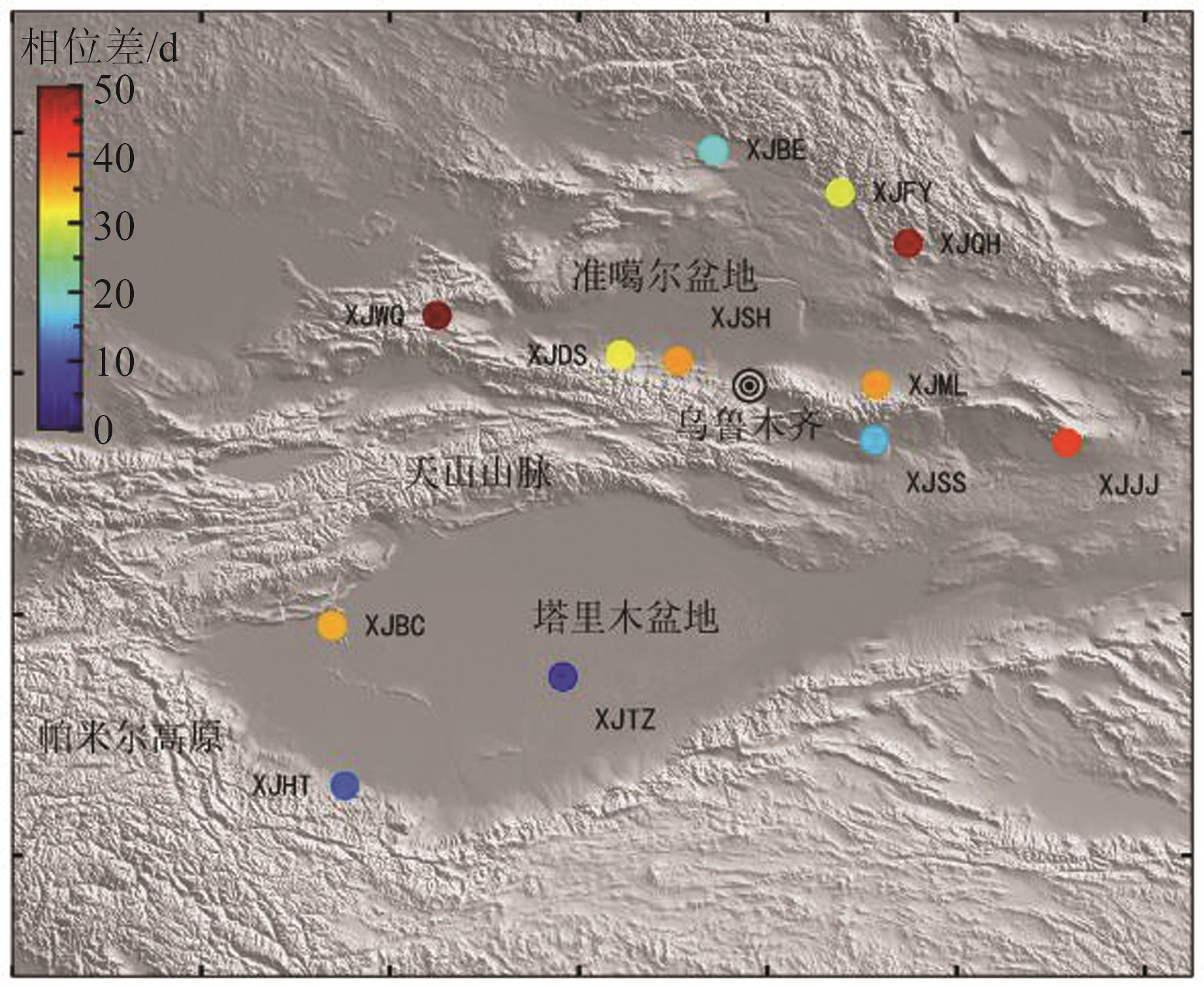Terrestrial Water Storage and Crustal Vertical Variation in Xinjiang Region,China Using Independent Component Analysis
-
摘要:
中国新疆地区水文气候变化复杂,其水储量变化及其负荷形变特征的精确提取极为重要。采用卫星重力数据GRACE(gravity recovery and climate experiment)反演新疆地区2010—2014年陆地水储量变化,利用独立成分分析法(independent component analysis,ICA)分解时空模式,提取时空特征信号。在此基础上,反演陆地水负荷迁移引起的地壳垂向变化,引入重力位系数与负荷勒夫数一阶项改正,回加非潮汐大气与海洋信号,结合尺度因子法校正GRACE反演结果,引入全球降水气候计划月降水资料分析形变影响,将其与测区12座连续运行参考站形变位移进行定量比较,重点分析各测站陆地水负荷信号与全球导航卫星系统(global navigation satellite system,GNSS)垂直位移的相关关系。结果表明,经ICA方法分解的新疆地区陆地水储量呈现多时间尺度特征,表现为明显的周年与长期变化;周年信号在西部帕米尔高原附近尤为显著;长期变化以逐年减少为主,在乌鲁木齐西部、天山一带信号较强;总体上,陆地水负荷垂直形变的时间序列波动幅度相对较小,幅值为-1.5~1.5 mm,与WGHM(WaterGAP global hydrology model)模型结果比较一致;形变时序与降水量变化除了存在明显的时间滞后之外,总体趋势相吻合;经非潮汐大气与海洋信号(non-tidal atmospheric and ocean model,GAC)改正后,GRACE结果与GNSS垂直位移的相关程度有所提升,各测站相关系数为0.63~0.91,加权均方根误差达16.18%~58.97%,相位延迟约为0.5~2个月。该研究方法可揭示新疆地区更为精细的水文信号特征,为区域参考框架精确维护提供重要技术支撑。
Abstract:ObjectivesIn recent years, the climate change in Xinjiang region,China is complex. It is of great significance to study the terrestrial water storage (TWS) and its load deformation for the accurate maintenance of the regional reference frame.
MethodsThe satellite gravity data GRACE(gravity recovery and climate experiment)was used to invert the changes of land water storage in Xinjiang region from 2010 to 2014, and the independent component analysis was used to decompose it into spatiotemporal models, and the spatial characteristics of multiple time scales were analyzed. On this basis, the correction on the first-order of gravity potential coefficient and load Love number is carried out, the correction of the non-tidal atmospheric and ocean model (GAC) from GRACE is introduced to obtain the vertical change of the crust caused by the migration of the land water load. The GRACE inversion results are corrected by scale factor method derived from WaterGAP global hydrology model (WGHM). The influence of deformation is analyzed by introducing monthly precipitation data from global precipitation climatology project. And the deformation displacements of the 13 continuously operating reference system stations in the survey area are quantitatively compared. The correlation between TWS load signal of each station and the annual vertical displacement of global navigation satellite system (GNSS) is analyzed.
ResultsThe results show that TWS in Xinjiang region presents multi-time scale characteristics, with obvious annual variation and long-term trend. The annual change is particularly significant near the western Pamirs Plateau, and the trend term is reflected in the long-term decrease year by year. The signal is relatively strong in the western Urumqi and Tianshan Mountains. In general, the change of land water load causes the vertical displacement of the crust in the study area, and the time series shows a small fluctuation with an amplitude of -1.5-1.5 mm, which is consistent with the deformation results of WGHM model. In addition to the obvious time lag, the time series of TWS load deformation and precipitation change are consistent with the overall trend. After GAC correction, the consistency between GRACE results and GNSS vertical displacement was enhanced, and the correlation coefficient and weighted root mean square(WRMS)were significantly improved. The correlation coefficient of each station was 0.63-0.91, and WRMS was 16.18%-58.97%.
ConclusionsThe research method in this paper can reveal more detailed hydrological signal characteristics in Xinjiang region, and the research results can provide important technical support for accurate maintenance of regional reference frame.
-
感谢德国法拉克福大学自然地理研究所提供的WGHM 2.2c全球陆地水储量模型。
http://ch.whu.edu.cn/cn/article/doi/10.13203/j.whugis20220573
-
表 1 新疆地区12个CORS站及其位置坐标
Table 1 The Names and Location Coordinates of 12 CORS Stations in Xinjiang Region
测站名 概略坐标 测站名 概略坐标 XJBC 78.77°E,39.81°N XJBE 86.85°E,47.69°N XJDS 84.88°E,44.31°N XJFY 89.53°E,46.99°N XJHT 79.04°E,37.16°N XJJJ 94.33°E,42.84°N XJML 90.29°E,43.80°N XJQH 90.97°E,46.15°N XJSH 86.10°E,44.20°N XJSS 90.25°E,42.89°N XJTZ 83.65°E,38.96°N XJWQ 80.99°E,44.96°N 表 2 GRACE监测的新疆地区地表负荷垂直形变与GNSS垂向位移之间的相关性指标
Table 2 Correlation Index Between Load Vertical Deformation Derived from GRACE and GNSS
测站 陆地水负荷形变 陆地水+非潮汐大气海洋负荷形变 相关系数 WRMS减小比值/% 相关系数 WRMS减小比值/% XJBC -0.68 -17.83 0.76 30.09 XJBE 0.27 3.63 0.90 46.34 XJDS -0.24 -10.56 0.81 41.12 XJFY 0.01 -3.42 0.81 39.31 XJHT -0.79 -22.79 0.70 22.09 XJJJ -0.10 -1.56 0.73 29.31 XJML -0.42 -5.37 0.79 35.20 XJQH -0.30 -11.21 0.68 25.80 XJSH -0.36 -5.58 0.79 29.02 XJSS -0.39 -6.88 0.91 58.97 XJTZ -0.60 -11.82 0.92 49.25 XJWQ -0.36 -23.10 0.63 16.18 表 3 GRACE监测新疆地区地表负荷垂直形变与GNSS垂直位移周年变化的振幅与相位
Table 3 Annual Amplitude and Phase Between GRACE with GAC Correction and GNSS Vertical Time Series
测站 GRACE GNSS GRACE-GNSS 周年振幅/mm 周年相位/d 周年振幅/mm 周年相位/d 相位差/d XJBC 3.53±0.05 -124±2 6.71±0.01 -89±1 35±3 XJBE 6.02±0.05 -138±1 9.87±0.01 -119±1 19±0 XJDS 5.08±0.03 -130±1 5.74±0.01 -99±1 31±0 XJFY 5.32±0.06 -132±2 7.85±0.03 -102±1 30±1 XJHT 2.01±0.06 -95±5 5.36±0.01 -84±1 11±4 XJJJ 4.30±0.05 -104±2 8.08±0.03 -63±1 41±1 XJML 4.72±0.06 -116±2 8.26±0.02 -80±1 36±1 XJQH 4.67±0.06 -126±2 5.98±0.02 -78±1 48±1 XJSH 4.70±0.04 -127±1 11.04±0.03 -91±1 36±0 XJSS 4.79±0.05 -112±1 5.11±0.01 -96±1 16±0 XJTZ 3.73±0.03 -98±1 6.07±0.02 -91±1 7±0 XJWQ 5.01±0.04 -138±1 5.32±0.01 -88±1 50±0 -
[1] 王杰龙, 杨玲, 陈义, 等. 结合季节调整和NAR神经网络的流域地下水储量预测[J]. 武汉大学学报(信息科学版), 2022, 47(10): 1796-1804. Wang Jielong, Yang Ling, Chen Yi, et al. Prediction of Watershed Groundwater Storage Based on Seasonal Adjustment and NAR Neural Network[J]. Geomatics and Information Science of Wuhan University, 2022, 47(10): 1796-1804.
[2] 冉将军, 闫政文, 吴云龙, 等. 下一代重力卫星任务研究概述与未来展望[J]. 武汉大学学报(信息科学版), 2023, 48(6): 841-857. Ran Jiangjun, Yan Zhengwen, Wu Yunlong, et al. Research Status and Future Perspectives in Next Generation Gravity Mission[J]. Geomatics and Information Science of Wuhan University, 2023, 48(6): 841-857.
[3] Othman A, Abotalib A Z. Land Subsidence Triggered by Groundwater Withdrawal Under Hyper-Arid Conditions: Case Study from Central Saudi Arabia[J]. Environmental Earth Sciences, 2019, 78(7): 243.
[4] Rateb A, Kuo C Y. Quantifying Vertical Deformation in the Tigris-Euphrates Basin Due to the Groundwater Abstraction: Insights from GRACE and Sentinel-1 Satellites[J]. Water, 2019, 11(8): 1658.
[5] Wang S Y, Chen J L, Wilson C R, et al. Reconciling GRACE and GPS Estimates of Long-Term Load Deformation in Southern Greenland[J]. Geophysical Journal International, 2017, 212(2): 1302-1313.
[6] Zhan W, Li F, Hao W, et al. Regional Characteristics and Influencing Factors of Seasonal Vertical Crustal Motions in Yunnan, China[J]. Geophysical Journal International, 2017, 210(3): 1295-1304.
[7] Han S C. Elastic Deformation of the Australian Continent Induced by Seasonal Water Cycles and the 2010-2011 LaNiña Determined Using GPS and GRACE[J]. Geophysical Research Letters, 2017, 44(6): 2763-2772.
[8] 盛传贞, 甘卫军, 梁诗明, 等. 滇西地区GPS时间序列中陆地水负荷形变干扰的GRACE分辨与剔除[J]. 地球物理学报, 2014, 57(1):42-52. Sheng Chuanzhen, Gan Weijun, Liang Shiming, et al. Identification and Elimination of Non-tectonic Crustal Deformation Caused by Land Water from GPS Time Series in the Western Yunnan Province Based on GRACE Observation[J]. Chinese J Geophys, 2014, 57(1):42-52.
[9] van Dam T V, Wahr J, Lavallée D. A Comparison of Annual Vertical Crustal Displacements from GPS and Gravity Recovery and Climate Experiment (GRACE) over Europe[J]. Journal of Geophysical Research Solid Earth, 2007, 112(B3):1426-1435.
[10] Tregoning P, Watson C, Ranmillien G, et al. Detecting Hydrologic Deformation Using GRACE and GPS[J]. Geophysics Research Letter, 2009b, 36(5): L1540.
[11] 闫昊明, 陈武, 朱耀仲, 等. 温度变化对我国GPS台站垂直位移的影响[J]. 地球物理学报, 2010, 53(4):825-832. Yan Haoming, Chen Wu, Zhu Yaozhong, et al. Thermal Effects on Vertical Displacement of GPS Stations in China[J]. Chinese J Geophys, 2010, 53(4):825-832.
[12] 谭伟杰, 许雪晴, 董大南, 等. 温度变化对中国大陆三维周年位移的影响[J]. 测绘学报, 2017, 46(9):1080-1087. Tan Weijie, Xu Xueqing, Dong Danan, et al. Thermoelastic Seasonal Deformation in Chinese Mainland[J]. Acta Geodaetica et Cartographica Sinica, 2017, 46(9): 1080-1087.
[13] Zhang T, Shen W B, Pan Y, et al. Study of Seasonal and Long-Term Vertical Deformation in Nepal Based on GPS and GRACE Observations[J]. Advances in Space Research, 2018, 61(5):120-121.
[14] 刘任莉, 李建成, 姜卫平, 等.联合GRACE与GPS比较山西省垂向地表形变[J].武汉大学学报(信息科学版),2013, 38(4): 426-430. Liu Renli, Li Jiancheng, Jiang Weiping, et al. Comparing Vertical Surface Displacements Using GRACE and GPS over Shanxi Province[J]. Geomatics and Information Science of Wuhan University, 2013, 38(4):426-430.
[15] 钟玉龙,钟敏,冯伟,等.联合GRACE重力卫星与实测资料估计西辽河流域蒸散发量[J].武汉大学学报(信息科学版),2020,45(2):173-178. Zhong Yulong, Zhong Min, Feng Wei, et al. Evaluation of the Evapotranspiration in the West Liaohe River Basin Based on GRACE Satellite and in Situ Measurements[J]. Geomatics and Information Science of Wuhan University, 2020, 45(2): 173-178.
[16] Landerer F. Monthly Estimates of Degree-1 (Geocenter) Gravity Coefficients, Generated from GRACE (04/2002-06/2017) and GRACE-FO (06/2018 Onward)RL06 Solutions, GRACE Technical Note 13, the GRACE Project, NASA Jet Propulsion Laboratory, 2019.
[17] Cheng M, Ries J. The Unexpected Signal in GRACE Estimates of C20[J]. Journal of Geodesy, 2017, 91(8): 897-914.
[18] Guo J, Mu D, Liu X, et al. Water Storage Changes over the Tibetan Plateau Revealed by GRACE Mission[J]. Acta Geophysica, 2016, 64(2):463-476.
[19] 刘任莉,佘敦先,李敏,等. 利用卫星观测数据评估GLDAS与WGHM水文模型的适用性[J].武汉大学学报(信息科学版),2019,44(11):1596-1604. Liu Renli, She Dunxian, Li Min, et al. Using Satellite Observations to Assess Applicability of GLDAS and WGHM Hydrological Model[J]. Geomatics and Information Science of Wuhan University, 2019,44(11):1596-1604.
[20] 王海波,游为,范东明,等.利用ICA方法提取奥卡万戈三角洲水储量变化信号[J].武汉大学学报(信息科学版),2022,47(1):93-103. Wang Haibo, You Wei, Fan Dongming, et al. Using ICA to Extract the Water Storage Variations Signals of the Okavango Delta[J]. Geomatics and Information Science of Wuhan University, 2022,47(1):93-103.
[21] Boergens E, Rangelova E, Sideris M G, et al. Assessment of the Capabilities of the Temporal and Spatiotemporal ICA Method for Geophysical Signal Separation in GRACE Data[J]. Journal of Geophysical Research: Solid Earth, 2014, 119(5): 4429-4447.
[22] Forootan E, Schumacher M, Mehrnegar N, et al. An Iterative ICA-based Reconstruction Method to Produce Consistent Time-Variable Total Water Storage Fields Using GRACE and Swarm Satellite Data[J]. Remote Sensing, 2020, 12(10): 1639.
[23] Shi T, Fukuda Y, Doi K, et al. Extraction of GRACE/GRACE-FO Observed Mass Change Patterns Across Antarctica via Independent Component Analysis (ICA)[J]. Geophysical Journal International, 2022, 229(3): 1914-1926.
[24] Zhang Z Z, Chao B F, Lu Y, et al. An Effective Filtering for GRACE Time-Variable Gravity: Fan Filter[J]. Geophysical Research Letters, 2009, 36(17):L17311.
[25] Pan Y, Shen W B, Ding H, et al. The Quasi-Biennial Vertical Oscillations at Global GPS Stations: Identification by Ensemble Empirical Mode Decomposition[J]. Sensors, 2015, 15(10): 26096-26114.
[26] Farrell W E. Deformation of the Earth by Surface Loads[J]. Reviews of Geophysics, 1972, 10(3):761-797.
[27] Blewitt G. Self-Consistency in Reference Frames, Geocenter Definition, and Surface Loading of the Solid Earth[J]. Journal of Geophysical Research: Solid Earth, 2003,108(B2): 2013-2023.
[28] 周伯烨, 姜卫平, 李昭. 非潮汐海洋负载效应对近海岸IGS测站坐标时间序列的影响[J]. 大地测量与地球动力学, 2016, 36(11): 1008-1013. Zhou Boye, Jiang Weiping, Li Zhao. Effects of Non-Tidal Ocean Loading on IGS Stations in Coastal Aras[J]. Journal of Geodesy and Geodynamics, 2016, 36(11): 1008-1013.
[29] Rao W,Sun W. Uplift of the Tibetan Plateau: How to Accurately Compute the Hydrological Load Effect? [J]. Journal of Geophysical Research: Solid Earth, 202, 127:e2021JB022475.
-
期刊类型引用(14)
1. 刘学习,朱守庆,陈国,张克非,郑南山,刘婧璇. 基于全球统一坐标框架的GNSS精密轨道与钟差产品一致性分析. 测绘学报. 2025(03): 432-447 .  百度学术
百度学术
2. 冯晓亮,陈欢,李厚芝. 不同观测环境中的多模GNSS数据质量自动化检测方法. 测绘工程. 2024(06): 56-61 .  百度学术
百度学术
3. 刘嘉伟,孙保琪,韩蕊,张喆,王侃,袁海波,杨旭海. GNSS多系统RTK授时性能分析. 导航定位与授时. 2023(03): 49-58 .  百度学术
百度学术
4. 王浩浩,郝明,庄文泉. GNSS实时卫星钟差估计在地震监测中的应用. 导航定位与授时. 2023(03): 108-116 .  百度学术
百度学术
5. 周长江,余海锋,王林伟,雷云平,岳彩亚. 无频间钟偏差改正的BDS-2三频非组合PPP随机模型优化. 测绘通报. 2023(12): 164-168 .  百度学术
百度学术
6. 潘丽静,刘翔,夏川茹,王雷雷. GNSS精密卫星钟差实时估计与分析. 城市勘测. 2021(06): 73-76 .  百度学术
百度学术
7. 郭磊,王甫红,桑吉章,张万威. 一种新的利用历元间位置变化量约束的GNSS导航算法. 武汉大学学报(信息科学版). 2020(01): 21-27 .  百度学术
百度学术
8. 陶钧,张柔. GPS/BeiDou/Galileo/GLONASS实时精密卫星钟差估计. 测绘地理信息. 2020(03): 102-106 .  百度学术
百度学术
9. 黄观文,王浩浩,谢威,曹钰. GNSS实时卫星钟差估计技术进展. 导航定位与授时. 2020(05): 1-9 .  百度学术
百度学术
10. 张浩,赵兴旺,陈佩文,谢毅. GPS/BDS卫星钟差融合解算模型及精度分析. 合肥工业大学学报(自然科学版). 2020(09): 1192-1196 .  百度学术
百度学术
11. 叶珍,李浩军. GNSS卫星钟差估计与结果分析. 导航定位与授时. 2019(03): 88-94 .  百度学术
百度学术
12. 盛剑锋,张彩红,谭凯. 一种全球导航卫星系统钟差估计优化方案的量化研究. 科学技术与工程. 2019(14): 14-21 .  百度学术
百度学术
13. 王尔申,赵珩,曲萍萍,庞涛,孙军. 基于拉格朗日插值法的卫星导航空间信号精度评估算法. 沈阳航空航天大学学报. 2019(04): 43-48 .  百度学术
百度学术
14. 李云,崔文刚. 精密单点定位技术发展及应用. 科学技术与工程. 2019(27): 1-11 .  百度学术
百度学术
其他类型引用(10)





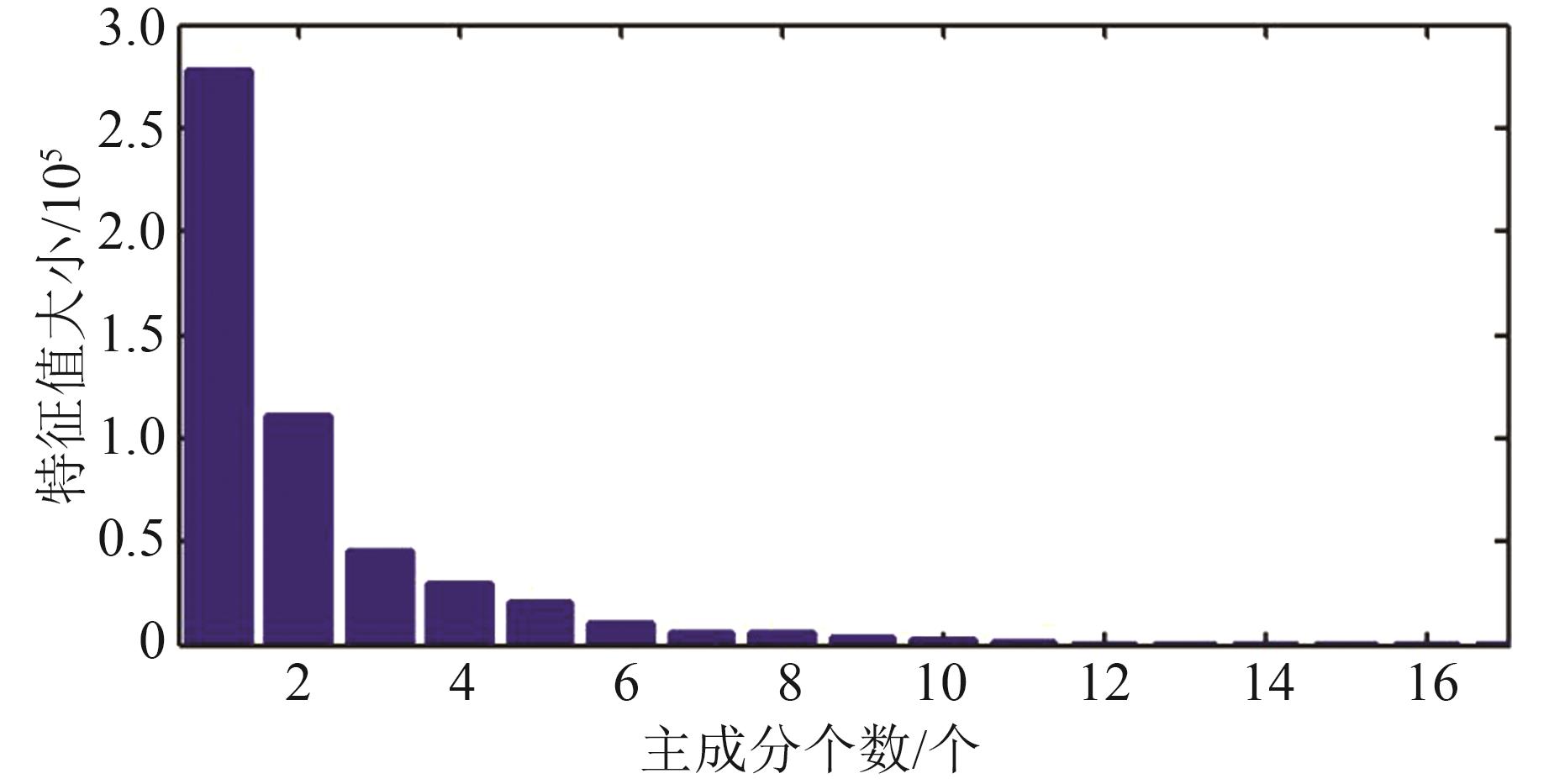
 下载:
下载:
